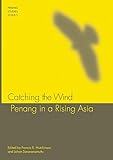Catching the Wind : Penang in a Rising Asia / ed. by Francis E. Hutchinson, Johan Saravanamuttu.
Material type: TextPublisher: Singapore : ISEAS Publishing, [2013]Copyright date: ©2013Description: 1 online resource (216 p.)Content type:
TextPublisher: Singapore : ISEAS Publishing, [2013]Copyright date: ©2013Description: 1 online resource (216 p.)Content type: - 9789814379878
- 9789814414357
- 959.5054
- HC445.5.Z7 P843 2012
- HC445.5
- online - DeGruyter
| Item type | Current library | Call number | URL | Status | Notes | Barcode | |
|---|---|---|---|---|---|---|---|
 eBook
eBook
|
Biblioteca "Angelicum" Pont. Univ. S.Tommaso d'Aquino Nuvola online | online - DeGruyter (Browse shelf(Opens below)) | Online access | Not for loan (Accesso limitato) | Accesso per gli utenti autorizzati / Access for authorized users | (dgr)9789814414357 |
Frontmatter -- CONTENTS -- FOREWORD -- FOREWORD -- ACKNOWLEDGEMENTS -- ABOUT THE CONTRIBUTORS -- INTRODUCTION -- 1. Situating Penang in Asia and Malaysia -- 2. George Town, Penang: Managing a Multicultural World Heritage Site -- 3. Heritage as Knowledge: Time, Space, and Culture in Penang -- 4. Heritage Conservation and Muslims in George Town -- 5. Investment Opportunities in Penang -- 6. Penang in the New Asian Economy: Skills Development & Future Human Resource Challenges -- 7. PBA Holdings Bhd: The Road to Privatisation, Corporatisation and Beyond -- 8. Penang’s Technology Opportunities -- 9. Building a Temporary Second Home: Japanese Long-stay Retirees in Penang -- 10. Medical Tourism in Penang: A Brief Review of the Sector -- 11. Penang’s Halal Industry -- REFERENCES
restricted access online access with authorization star
http://purl.org/coar/access_right/c_16ec
However impressive the economic success of Penang has been over the past four decades, structural conditions in the region call for a fundamental reconfiguration of this Malaysian state’s competitive advantage.In the 1970s, the ageing entrepôt transformed itself into a manufacturing hub for the electronics industry and a well-known tourist site. This outward-looking model of economic growth has underpinned Penang’s economic development up until the present. The question that now arises is whether Penang’s present mode of development will continue to be effective, or whether it will have to transform itself. First, Malaysia in general, and Penang in particular are caught in a middle-income trap. Second, while the evolving weight of the global economy is shifting towards Asia, many of its emerging powers are competing with Penang in areas where it formerly excelled. Third, Penang is a state within a federation, and its capital, George Town, is a secondary city. Neither can rival Kuala Lumpur in terms of size or facilities, and thus must offer investors other attributes. Effectively meeting these challenges while retaining Penang’s vibrant and living culture are the key issues that are dealt with in this second volume of the Penang Studies Series.
Mode of access: Internet via World Wide Web.
In English.
Description based on online resource; title from PDF title page (publisher's Web site, viewed 01. Dez 2022)


